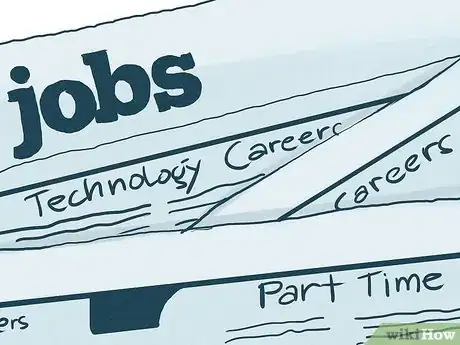This article was co-authored by Adrian Klaphaak, CPCC. Adrian Klaphaak is a career coach and founder of A Path That Fits, a mindfulness-based boutique career and life coaching company in the San Francisco Bay Area. He is also is an accredited Co-Active Professional Coach (CPCC). Klaphaak has used his training with the Coaches Training Institute, Hakomi Somatic Psychology and Internal Family Systems Therapy (IFS) to help thousands of people build successful careers and live more purposeful lives.
There are 12 references cited in this article, which can be found at the bottom of the page.
This article has been viewed 64,749 times.
If you like the company you are working for but need to make a slight job change in regards to your location or department, you can explore your options for a lateral transfer. A lateral transfer means you either stay in the same job or move to a comparable job (on the same level). For example, a sales manager position in a different location or for a different sales division. Even though you are already working for the company, making a transfer may not be as easy as you think. In order to maximize your chances of a successful transfer you need to make the decision, search for openings, and interview and prepare for a transfer.
Steps
Making the Decision to Transfer
-
1Assess why you want to transfer. What is your basic motivation? Are you bored? Disaffected? Do you need a bigger challenge? Is your job too demanding and you want a better work-life balance? Be sure that you are making an educated decision. Transferring departments is doable – for example, 1/3 of the British grocery chain Sainsbury’s 500 yearly recruits for retail management transfer to other operations[1] -- but you should have a good reason. Try putting your thoughts on paper. Don’t over-think or over-rationalize. Write down why you feel the need to move, emotions and all.
-
2Evaluate your reasons. Now that you’ve stated your reasons, it is time to decide whether they are legitimate. Understand that some reasons to transfer are good and others not as good. For example, you may be new to your department and not feel suited to the job. Improper fit is a legitimate reason to transfer. So is the desire for a greater challenge or the need to balance your life. Simple boredom or unhappiness need more thought, though. All jobs have ups and downs. What is behind your boredom? Is it something that might change after a time, like routine? Or is it a bigger problem, like you feel unchallenged and unmotivated?
- More good reasons to transfer include relocating to different state or part of town, seeking better team or department fit, issues with your direct supervisor, and striving to meet career goals your current job cannot offer.
- Less compelling reasons include taking issue with company policies or procedures, ethical concerns, or problems with executive level management. None of the above will change much with a transfer and you may find yourself leaving the company shortly after transferring.
- Do not be think that a transfer will be a quick fix for your personal and/or work issues. If your issues wind up being company-wide, the grass may not be greener on the other side.
- It may be harder to transfer if you work for a small company, where many co-workers are “lifers” and roles are clearly set. In that case, an external move might be better.[2]
Advertisement -
3Network and build strong relationships. Network with those you are interested in working with to help your chances of landing a transfer. Building genuine, mutual connections and making yourself known will help you find advocates – advocates who can promote your cause.[3] Get to know the people in departments or locations in which you have an interest. For example, if you are interested in accounting, casually say so the next time you bump into the hiring manager in the break room. If you make it clear that you are interested, he may alert you the next time a new financial analyst position opens up. Keep in mind that knowing an insider will not get you hired, but that it may get you a close look.
- Networking can be easier at a small company, with fewer steps. Does your boss or the owner do all the hiring herself? Talk to her frankly about your interest. If she is amenable, she might come directly to you the next time she is looking to hire. She may even allow you to apply before others.
-
4Research and apply for internal job openings. Many companies make job openings available to current employees before they are advertised outside of the company. Be on the lookout for such postings. Try to find them on the company intranet, in the break room, or by asking HR. Use your network to get info. For example, if you’d like to transfer to the marketing department and sometimes talk with Sarah in marketing as part of your current job, ask her about possible openings. Even if nothing is available at the moment, she may alert you in the future when a job opens. If you know someone in HR, mention your interest there. Once you have found a suitable position, put forward a professional application. But be discreet – other people you know will apply for the same vacancy.[4]
- Take the process seriously. The biggest mistake you can make is to assume that you will get special consideration as a “known entity.” In fact, this might actually make things harder, as no one wants to be accused of cronyism. Act as you would with any outside job. Follow the process, submit an up-to-date resume, a first-rate cover letter, and approach the application with professionalism.
- You may have an advantage if you are allowed to apply for the job before outsiders. However, you may not. Remember that others at your company could also be pursuing the same opportunity.
- Be selective about applying for internal jobs. Management will take you less seriously if they know that you apply for anything and everything.[5]
-
5Be upfront with your supervisor. Make sure that your direct supervisor and HR know about your application. You should avoid giving insult at all costs. If you have an understanding boss, for example, you could hurt her and lose a powerful advocate by not being upfront. She might be able to put in a good word for you.[6] If, on the other hand, your boss is easily offended, try to be as diplomatic as possible with her about your desire to transfer. Make it clear that the issue is not personal – e.g., “You’re a great supervisor and I’ve really enjoyed working for you. It’s only that I want to expand my career opportunities.” She will find out eventually and it is better that she hear it from you.
- If you don’t feel comfortable going to your supervisor or your supervisor is the reason that you want to transfer, seek advice from your HR representative. You will still have to face your supervisor, but HR can guide you through it.[7]
Interviewing and Preparing to Transfer
-
1Take the interview seriously. Most likely you will have to go through a formal interview before you can transfer to a new position. Act as if you are an entirely new applicant during this process. Do not assume you have an edge, even if you might. Keeping this mindset will force you to stay as professional as possible for the duration and give you the best possible chance to get the job. As in preparing your application, the biggest mistake you can make is to be under-prepared, thinking that you have an inside track. To hiring managers this seems unprofessional and arrogant.[8]
- As the Harvard Business Review points out, there are many things that can negate your potential advantage as an insider. The hiring manager will be influenced by his past. He might have had a bad experience with a previous inside hire, for example, and treat you with extra scrutiny. You should not “rest on your laurels.”[9]
- At a small company the interview process may be less formal. Do not take this to mean “less professional”! If anything, the fact that you probably know your interviewer makes professionalism all the more important. You should still research and prepare and be dressed appropriately, perhaps in a smart business-casual style.[10]
-
2Follow proper interview etiquette. When you interview for a transfer position, treat it just as formally as if you were interviewing for a new company. Dress appropriately, meaning, in general, a clean blue or black business suit for men and women – and make sure that it is crisp and wrinkle-free. Bring a copy of your resume, arrive early, and greet your interviewer with a firm handshake and smile. Ask thoughtful questions, showing your preparation and knowledge of the position. Do not slouch and maintain friendly eye contact. Finally, thank the interviewer, ask about the next steps, and follow up within a few days with a formal, written thank you note.[11]
-
3Follow through with your old job. Continue to work hard at your position until you are able to transfer. Since you want to stay with the company, you should do your best to maintain a good working relationship with your current supervisor and/or team while signalling to your potential or new supervisor and/or team that you are serious about the job. Do not slack off. Continue to arrive on time, complete your duties thoroughly, and follow the rules as set forth in the company’s formal policies. If your interview fails, you could otherwise risk your employment or a chance to transfer in the future.[12]
-
4Tie up loose ends. Congratulations! You’ve been hired and are transferring to a new department. Before you go, however, make sure to ease the transition for your old manager, co-workers, and replacement. Departures, especially abrupt ones, can throw whole departments into chaos, and the last thing that a new employee wants is take over someone’s mess. As said, continue to do your job to the best of your ability until the final day. Finish any projects or other tasks before you leave, if at all possible. By doing so you will show your dedication, help your outgoing manager and co-workers, and let your replacement start fresh without having to clean up after you. By not tying up loose ends, you can burn bridges with old colleagues. To them, this sort of behavior says, “I really only think about myself and my personal advancement.”[13]
-
5Show your replacement the ropes. Before you leave, it is a great help and mercy to show your replacement the tricks of the trade. You are uniquely qualified to show them not only what is written in the job description but how things are actually done – e.g., “Despite what you’ve been told, you really have to write two monthly reports. One to the supervisor and one directly to sales.” This knowledge will help them pick up where you left off. Make a list of all of your duties, for example, with a sample daily and weekly schedule. Also consider putting together a “continuity folder” with step-by-step instructions for the job’s major tasks, including sample letters, reports, logbooks, and other models. You can even arrange to shadow your replacement for several days. Training your successor will allow you to leave gracefully, and is an experience that will enhance your resume.
- As a final gesture, make yourself available in case problems arise. Give your replacement your email address or internal telephone number, saying, “Please get in touch if you have any questions.” Even if she chooses not to reach out, you will leave with a final good impression.
Community Q&A
-
QuestionWhen should you quit a job you hate?
 Adrian Klaphaak, CPCCAdrian Klaphaak is a career coach and founder of A Path That Fits, a mindfulness-based boutique career and life coaching company in the San Francisco Bay Area. He is also is an accredited Co-Active Professional Coach (CPCC). Klaphaak has used his training with the Coaches Training Institute, Hakomi Somatic Psychology and Internal Family Systems Therapy (IFS) to help thousands of people build successful careers and live more purposeful lives.
Adrian Klaphaak, CPCCAdrian Klaphaak is a career coach and founder of A Path That Fits, a mindfulness-based boutique career and life coaching company in the San Francisco Bay Area. He is also is an accredited Co-Active Professional Coach (CPCC). Klaphaak has used his training with the Coaches Training Institute, Hakomi Somatic Psychology and Internal Family Systems Therapy (IFS) to help thousands of people build successful careers and live more purposeful lives.
Career Coach There might be a lot of reasons why you feel you should leave your job. It can be scary to change careers, so you might ignore your feelings of discontent for months or even years. However, it might be time to make a change if you're feeling disengaged or uninspired at your job, or you might feel drained by your work. You might also benefit from change if your career has stagnated and you don't have any opportunities for growth, if you're undervalued, or if you are working in a toxic culture.
There might be a lot of reasons why you feel you should leave your job. It can be scary to change careers, so you might ignore your feelings of discontent for months or even years. However, it might be time to make a change if you're feeling disengaged or uninspired at your job, or you might feel drained by your work. You might also benefit from change if your career has stagnated and you don't have any opportunities for growth, if you're undervalued, or if you are working in a toxic culture. -
QuestionHow can I move from McDonald's in South Africa to one in the U.K.?
 Community AnswerSpeak with someone in the HR department, or you can just apply through your trusted job portal or McDonald's website mentioning that you are already employed by them and that you are moving and would like a transfer.
Community AnswerSpeak with someone in the HR department, or you can just apply through your trusted job portal or McDonald's website mentioning that you are already employed by them and that you are moving and would like a transfer. -
QuestionWhat reasons can I give for requesting a transfer to a medical assistant job?
 Community AnswerWell, you could say you wanted or were ready for something new, and you should be able to do what you want with your life. The best choice would be to just explain to your boss honestly why you want to transfer. If you're unhappy in your current job for specific reasons, mention those too - your boss may want to correct them with or without transferring you.
Community AnswerWell, you could say you wanted or were ready for something new, and you should be able to do what you want with your life. The best choice would be to just explain to your boss honestly why you want to transfer. If you're unhappy in your current job for specific reasons, mention those too - your boss may want to correct them with or without transferring you.
References
- ↑ http://www.theguardian.com/money/2000/dec/09/jobsadvice.careers3
- ↑ http://www.careerealism.com/changing-jobs-current-employer/
- ↑ https://www.gsb.stanford.edu/insights/ten-tips-building-stronger-networks-work-life
- ↑ http://www.dummies.com/how-to/content/how-to-apply-for-an-internal-job-vacancy.html
- ↑ http://www.dummies.com/how-to/content/how-to-apply-for-an-internal-job-vacancy.html
- ↑ http://career-advice.monster.com/career-development/changing-careers/apply-for-an-internal-job/article.aspx
- ↑ https://hbr.org/2013/07/how-to-ace-an-internal-intervi
- ↑ http://www.forbes.com/sites/lisaquast/2014/08/04/job-seekers-7-tips-on-applying-for-a-job-within-your-company/
- ↑ https://hbr.org/2013/07/how-to-ace-an-internal-intervi
- ↑ http://www.theemployable.com/index.php/2014/08/05/5-tips-informal-job-interviews/
- ↑ https://www.themuse.com/advice/the-10-rules-of-interview-etiquette
- ↑ http://www.forbes.com/sites/lisaquast/2014/04/14/job-seekers-how-to-gracefully-quit-your-job/
- ↑ https://hbr.org/2014/12/how-to-quit-your-job-without-burning-bridges


























































